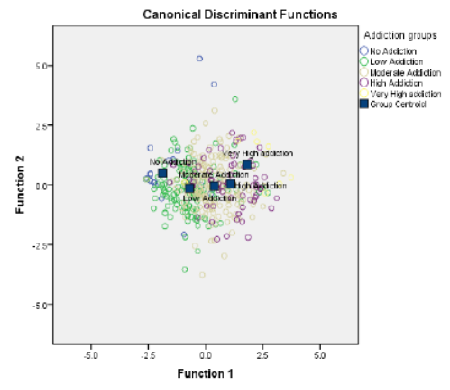


Indian Journal of Science and Technology
DOI: 10.17485/IJST/v17i25.1355
Year: 2024, Volume: 17, Issue: 25, Pages: 2622-2634
Original Article
Bindiya Tater1∗, Kishor John2
1Assistant Professor, Department of Management Studies, Medicaps University, Indore, Madhya Pradesh, India
2Professor & Director, Library & EMPRC, M.P. Bhoj Open University, Bhopal, Madhya Pradesh, India
*Corresponding Author
Email: [email protected]
Received Date:25 April 2024, Accepted Date:07 June 2024, Published Date:19 June 2024
Objectives: The study aimed to investigate the influence of varying levels of addiction, ranging from no addiction to extremely high addiction, on the physical and mental well-being of Indian students. Methods: The study is descriptive and based on the survey method. The six constructs and 15 physical and mental well-being items were assessed on the 5-point Likert scale. The composite scores were computed and classified into five categories. Findings: The results revealed that students aged 18-22 and 23-27 heavily rely on smartphones to explore their identity, socialize, and engage in academic and professional endeavours; male and female students and 91% of Professional/vocational training students exhibit the highest frequency of moderate addiction. Students (39%) spend 2-4 hours on smartphones daily based on individual preferences, habits, and lifestyle factors. A positive correlation was found between age and addiction group as well as between addiction group and smartphone usage, and negative correlations were found between smartphone usage and age groups. A significant correlation exists between an inability to control carvings (ICC), dependency (D), Conflict (C), Over-Usage (OU) and Withdrawal and Escape (WE), and all these have the greatest contribution to the first variate. MANOVA Analysis Pillai's Trace (<0.001); Wilks' Lambda (<0.001); Hotelling's Trace (<0.001); Roy's Largest Root (<0.001) revealed substantial disparities among groups stratified by addiction severity spanning from no addiction to extremely high addiction across a spectrum of physical and mental well-being dimensions among Indian students. The discriminant function plot effectively illustrated the discernment achieved in varying levels of smartphone addiction, notably accentuating differences among moderate (0.370), high (1.091), and extremely high (1.803) addiction categories. Novelty: This study investigated how varying levels of addiction exert influence on both physical and mental well-being and shed new light on this multifaceted relationship, particularly among students within the context of Indian academia.
Keywords: Smartphone Addiction, Physical and Mental Wellbeing, Usage Patterns, Smartphones, Indians, Students
© 2024 Tater & John. This is an open-access article distributed under the terms of the Creative Commons Attribution License, which permits unrestricted use, distribution, and reproduction in any medium, provided the original author and source are credited. Published By Indian Society for Education and Environment (iSee)
Subscribe now for latest articles and news.